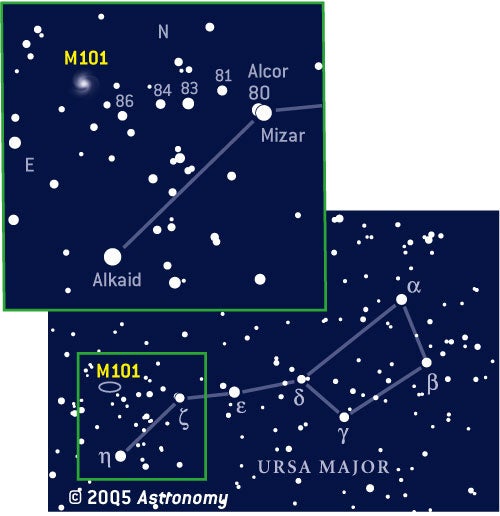In a perfect universe, each nebula, cluster, or galaxy would be located next to a naked-eye field star. Center the star in the finder scope, peer into the telescope, and — voilà! — near the star is that 10th-magnitude galaxy! In reality, though, you need to consult a star atlas to select the bright star nearest your quarry, as well as dimmer stars bridging the gap between them. With your telescope, you then “star hop” — like a frog across a path of lily pads — from the bright star to your target object.
Star hopping isn’t the only way to track down sky objects. Many of today’s top-of-the-line telescopes include either setting circles or computerized “go-to” systems to carry you to your target. As useful as setting circles and go-to electronics are, using them is like boarding a tour bus and traveling blindfolded until you arrive at your destination. Think of all the sights you’ll miss along the way.
To start hopping, let’s explore the galaxy M101, located in Ursa Major (refer to the finder chart on this page). Although listed as magnitude 8, M101 can be difficult for small scopes because its light is spread out over an area roughly two-thirds the Moon’s apparent diameter. Save M101 for a clear, dark night.
Mizar’s naked-eye neighbor Alcor (80 UMa) points to a row of 5th- and 6th-magnitude stars that leads the way to M101. Follow these stellar lily pads either through your finder or the main scope (use low power) until you come to 86 Uma.
The rest of the journey will be made with the main scope, rigged with an eyepiece that covers at least a 1-degree (°) (2 Moon-diameter) field. After you’ve oriented the finder chart to match what you see through your telescope, star hop your way from 86 UMa to M101. If you spy a faint, circular patch of light in the location shown on the chart, you’ve found M101!
An entry in my astronomy logbook dated May 11, 1977, describes how M101 might appear to the novice using a small-aperture telescope. Having observed M101 for the first time with a 3-inch reflecting telescope, I wrote: “This galaxy is a ‘presence’ — a ghost in the field. It would be impossible [to see] in any area near bright lights.”
To me, M101 seemed to be 7 or 8 arcminutes (‘) across (about one-fourth the Moon’s apparent diameter) — a fraction of the size suggested by long-exposure photographs. M101 is a face-on spiral galaxy. Peering into the eyepiece, I was looking at light that left M101 some 25 million years ago! Read more about M101 in “A spiral masterpiece” on page 62.
If you want more information on star hopping, I refer you to the following publications: A Star Hopper’s Guide to the Messier Objects by Lenore Freeman Morales; Turn Left at Orion by Guy Consolmagno and Dan Davis; and Star-Hopping: Your Vista to Viewing the Universe by Robert A. Garfinkle. All explain star-hopping techniques and include charts to help you find deep-space wonders easily.
In the 35 years I’ve been an astronomy enthusiast, I’ve made tens of thousands of telescopic observations. I’ve observed objects from our Moon, which is 1.3 light-seconds away, to quasars billions of light-years distant.
Anything invisible to the naked eye I found by star hopping. Maybe it isn’t a dance, but the “Star hop” makes me feel as though I’m waltzing around the heavens with my telescope.
Get ready to take a close-up look at our nearest star. I’ll talk about how to view the Sun safely. Questions, comments, or suggestions? E-mail me here.











